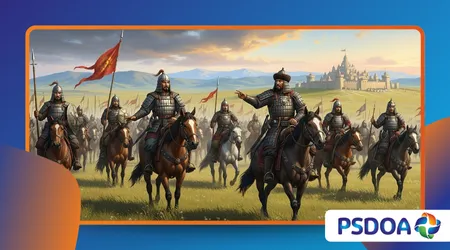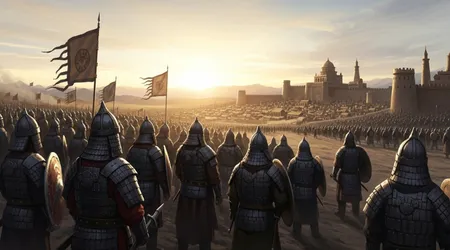How the Mongol Empire Was More Than Just War

The Mongol Empire has long been unfairly defined solely by the swift, brutal conquests of Genghis Khan. This pervasive, simplistic narrative overlooks a far more complex and transformative historical reality.
Anúncios
We must look beyond the siege and the saber to understand its massive scope. This pivotal era is historically known as the Pax Mongolica, a time of relative, if enforced, peace.
It dramatically reshaped the medieval world map, uniting distant, previously isolated civilizations under a single, overarching political authority. The systematic movement of goods, vital ideas, and countless people exploded in volume.
The empire’s reach was a world-changing catalyst for globalism centuries before the European Age of Exploration ever began.
It fundamentally accelerated the reliable transfer of crucial technologies and vital intellectual information between the Asian East and the European West. Understanding this powerful era is key to grasping modern global connectivity.
Anúncios
The persistent academic focus on military campaigns and battles neglects the truly profound administrative and institutional innovations.
The sheer scale of the Mongol Empire necessitated pragmatic, effective solutions for intercontinental governance and rapid communication. Let us delve into this forgotten infrastructure and its lasting effects.
How Did Mongol Administration Become the Engine of Eurasia’s Commerce?
Managing an empire that spanned from the Danube River to the Pacific Ocean demanded sophisticated organizational capacity.
The Mongols, initially a nomadic people, quickly adopted and ingeniously adapted governing structures from their conquered, sedentary populations.
They fundamentally prioritized proven merit over entrenched aristocracy in their vast bureaucracy. They often employed talented Uighurs, Persians, and Chinese administrators who possessed superior local knowledge.
This pragmatic, results-oriented approach ensured efficiency and skill in maintaining the empire’s continental functionality.
Competence was undeniably valued above tribal affiliation in their expansive administrative framework. This inclusive policy was a massive strength, drawing on the best minds across a diverse geography.
The empire essentially acted as a powerful clearinghouse for bureaucratic excellence.
++ The Great Famine: Causes and Cover-Ups
What Was the Yassa and Why Did It Stabilize Trade?
Genghis Khan established the Yassa, a detailed, powerful written code of law, to govern both the Mongols and the many subjugated populations.
This consistent legal framework provided a predictable, uniform structure across incredibly diverse regions. Its scope was surprisingly advanced for the 13th century.
The Yassa codified specific laws on everything from strict military discipline to transparent property rights and systematic taxation.
Its strict enforcement drastically helped reduce local conflicts and suppressed endemic banditry along vital trade arteries. Stability always equals prosperity for merchants and travelers.
The consistent rule of law, though it was certainly harsh by modern standards, was explicitly clear and universally applied throughout the Mongols’ enormous domain.
This institutional transparency was a major draw for international merchants seeking predictable and reliable conditions for their lucrative commerce.
Furthermore, the Yassa provided merchants with specific legal protections, unlike in many fractured European kingdoms.
Also read: The Untold History of Pre-Columbian America
How Did the Yam System Revolutionize Communication?
The Yam, or Mongol postal relay system, was an organizational masterpiece and a key innovation in world history.
It guaranteed rapid, secure transmission of governmental edicts and crucial military intelligence across the entire colossal empire. This network was unparalleled globally until the modern era.
Couriers could travel over 200 miles a day, utilizing thousands of strategically placed, well-stocked relay stations (otok or jam-ts).
The reliability of this rapid network was absolutely vital for maintaining effective imperial control over vast, disparate distances.
This rapid network was later expanded to facilitate essential commercial and diplomatic travel, acting as a secure “superhighway” for people like the famous Venetian merchant, Marco Polo. It drastically reduced intercontinental travel times and risks across huge swaths of Eurasia.
The guaranteed safety and astounding speed of travel along the Yam system allowed for truly long-distance, high-volume commerce that had been practically impossible for centuries.
This logistical triumph underpinned the economic reality of the Pax Mongolica.

Why Did Mongol Tolerance Spark a Cultural Convergence?
Contrary to the persistent, outdated “barbarian horde” stereotype, the Mongol rulers were pragmatically tolerant regarding both religious and complex cultural practices.
This policy of non-interference was not moral but a highly effective, cold, pragmatic tool of stable governance.
The empire deliberately granted significant tax exemptions and crucial legal protections to the leaders of all major religions, including Buddhists, Muslims, Christians, and Taoists.
This specific policy ensured greater local loyalty and significantly reduced the potential for widespread internal religious dissent.
This resulting atmosphere of religious and cultural pluralism allowed for an unprecedented, dynamic cross-pollination of new ideas and necessary technologies.
Scholars, artisans, and skilled physicians traveled freely, often receiving direct encouragement and patronage from the Khans themselves.
Read more: Unearthing the Gallus Revolt: Coins and Tunnels of Resistance in Roman Galilee
What Specific Technologies Were Transferred Across the Mongol Superhighway?
One truly world-altering practical example of this exchange is the critical transfer of the powerful Chinese technology of printing (specifically woodblock and eventually movable type) westward into the Persian Ilkhanate.
This technology significantly impacted the development of historical documentation.
Another incredibly important example is the movement of advanced knowledge concerning complex cartography and precise astronomical observation from the Islamic world into the Yuan Dynasty in China.
The knowledge exchange worked dynamically both ways, mutually enriching all participating parties.
Think of the Mongol Empire as a powerful, centralized router for the medieval internet it wasn’t the creator of the data, but it facilitated the speed and safety of its transmission.
This analogy highlights their central role as network managers rather than primary innovators. A relevant real-world statistic underscores this profound historical role:
In fact, historian Thomas T. Allsen noted that the volume of trade along the Eurasian routes under the Pax Mongolica experienced a “sustained and unprecedented increase.”
This rise was not merely a passive recovery but an actively engineered commercial boom. The Mongol willingness to hire skilled professionals from defeated populations, regardless of their origin or creed, was groundbreaking.
It was an early, crude form of meritocracy focused entirely on imperial utility and pragmatic need. This practice created a powerful dynamic of intellectual and technical mobility.
Why Did the Mongol Empire Elevate Merchants and Artisans?
The Mongols themselves were not great sedentary producers of goods but were consummate consumers and facilitators of trade. They understood that a wealthy merchant class meant greater tax revenue for the imperial treasury.
Therefore, they deliberately elevated the social and legal status of merchants, offering them specific privileges like greater security and low-interest loans.
They used the paiza, an imperial passport, to grant merchants safe passage across the vast network. Imagine a high-value merchant traveling from Venice to Beijing: under Mongol rule, they faced fewer tolls, less banditry, and only one consistent legal system for protection.
In 1300, no other global power offered this degree of intercontinental commercial security.
The Mongols also forcibly relocated tens of thousands of skilled artisans and craftsmen to where their labor was needed most.
This ensured the rapid transfer of technical skills, from shipbuilding to advanced metallurgy, across the entire empire. This was a brutal but highly effective diffusion mechanism.
How Did the Mongol Empire Impact Modern Global Geopolitics?
The direct political fragmentation of the Mongol Empire into the four major successor Khanates (Golden Horde, Ilkhanate, Chagatai Khanate, and Yuan Dynasty) started after 1260. Yet, their institutional and cultural framework persisted for centuries.
The lasting impact of the Mongol governance can still be seen in the centralized, bureaucratic systems of Russia and Ming China, both of which inherited key Mongol organizational features. Modern centralized state-building often owes a debt to this system.
How Was the Mongol Legacy a Double-Edged Sword?
While the Mongols facilitated trade, they also inadvertently facilitated the rapid, deadly spread of the Bubonic Plague (Black Death) westward into Europe. The unified routes, their great achievement, were a deadly conduit.
This horrific event, which peaked in the mid-14th century, serves as a powerful historical reminder: the cost of globalization, even in its earliest form, includes the swift, uncontrolled movement of contagions.
Progress and peril are frequently two sides of the same historical coin. The Mongol-era stability led to an economic surge, but the collapse of that stability in the mid-14th century caused profound disruption.
This destabilization contributed directly to the shift in European focus toward maritime exploration.
The desire to circumvent the now-fractured, dangerous overland routes of the old Silk Road became a major driver. Christopher Columbus’s search for a sea route to the wealth of Asia was, in a twisted way, an enduring legacy of the Mongol Empire.
The question must be asked: If the Pax Mongolica had endured, would the Age of Exploration have occurred in the same way, or at all? It is a compelling counterfactual that highlights the Mongols’ profound role.
| Exchange Type | Origin to West | West to Origin | Lasting Impact |
| Technology | Printing, Gunpowder, Compass, Porcelain | Advanced Astronomy, Cartography, Algebra | Foundation for European Renaissance Science |
| Commodity | Silk, Spices, Tea, Paper Money (chao) | Silver, Textiles (Wool), Furs, Glassware | Increased global demand for Asian goods |
| Culture/Ideas | Chinese Historical Documentation, Daoism | Western Christianity (Nestorian/Catholic), Islamic Medical Texts | Religious pluralism in early global governance |
In conclusion, reducing the Mongol Empire to a simple tale of blood and conquest means missing one of the most critical chapters in world history.
They were the accidental globalists of the medieval world. Their pragmatic focus on efficient law (Yassa), rapid communication (Yam), and the patronage of commerce created the first integrated, transcontinental economy.
This unprecedented system laid the forgotten groundwork for the globalized world we inhabit in 2025. It is our duty, as students of history, to recognize the full complexity of this transformative, massive, and truly enduring legacy.
We must remember the Mongol role in the transmission of the compass, gunpowder, and printing innovations that irrevocably propelled the modern world.
Share your thoughts on this complex historical legacy in the comments below! What other “barbarian” empires deserve a nuanced re-evaluation?
Frequently Asked Questions (FAQ)
Was the Pax Mongolica truly peaceful, considering the initial massacres?
Historians view the Pax Mongolica as a period of relative peace and high security after the initial, brutal conquests were completed.
It refers specifically to the internal stability and safety for travel within the unified Mongol-ruled territories from approximately 1270 to 1350, which drastically contrasted with the fragmented pre-Mongol world.
How did the Mongol Empire handle paper money?
The Yuan Dynasty (Mongol-ruled China) developed and heavily promoted paper money, known as chao, long before European nations.
This innovation, learned from the Chinese, facilitated large-scale, long-distance trade by eliminating the need to transport heavy metal coinage across the vast empire.
Did the Mongols invent gunpowder or the compass?
No. The Mongols did not invent either, but they were the primary historical force responsible for the transmission of these Chinese inventions westward to the Islamic world and Europe.
Their integrated supply chains and forced relocation of artisans ensured these technologies spread faster than ever before.
